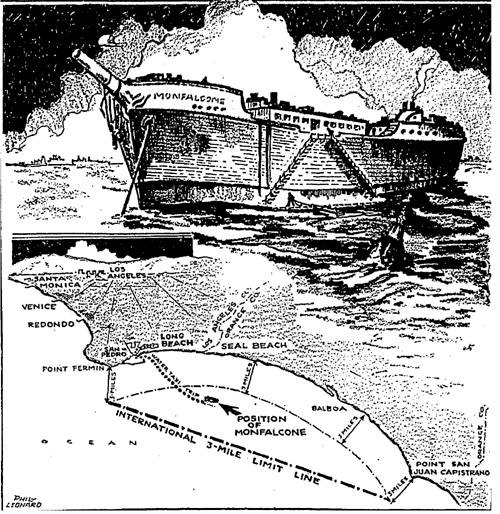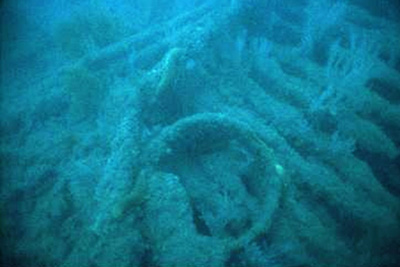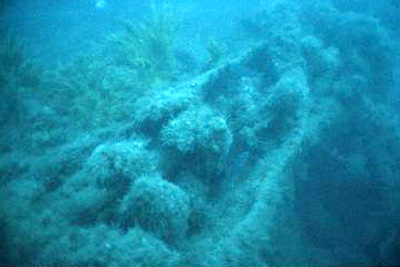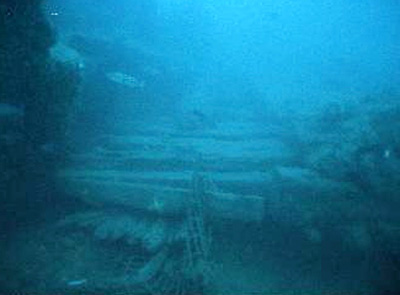Monfalcone
| Other Names: Gambler | Date of Sinking: August 28, 1930 | |||
| Rig/Type: Five masted Barkentine/Barge | Cause of Sinking: Fire | |||
| Length: 282' | Breadth: 45.8' | Tons: 2,418 | Cargo: Passengers/Gambling Equipment | |
| Built: 1919 in Orange, Texas | Location: Long Beach | |||
| Hull Construction: Oak | Depth: 70' | Visibility: 3-15' | ||

Above: A sketch of the Monfalcone as a gambling barge. Below: A theoretical boundary created by law enforcement desperately trying to remove the menace of the gambling barges.
On May 30, 1923, the five masted barkentine Monfalcone left New Orleans for Los Angeles, where she was to unload her cargo and begin her new trade on the Pacific Coast hauling lumber. However, three days out, she was struck by a hurricane, dismasted and lost much of her deck cargo. Blown hundreds of miles off course, she eventually limped into Colon, near the Panama Canal with her crew half starved and low on water. The salvage tug Peacock towed her 3,000 miles to Los Angeles and on November 7, 1923 she was auctioned off to Capt. A. R. Paulsen and Ivar Bell for $5,250, considered a small sum for one of the largest sailing vessels afloat at the time.
She was soon moved to the Craig Shipyard for re-rigging and repairs. Described as "...a beautiful craft with lines modeled directly after the old clippers. She has a deep, sweeping shear, a finely modeled stern, while surmounting her true clipper bow is the figurehead of an American bald eagle." Such an attraction lured the Hollywood Photoplay Productions to use her as a set for "Puppy Love" in May of 1924.
In 1925, most sailing vessels were laid up due to poor market conditions and competition from steamers. By 1928 G. Act Twe, W.W. Wells and I. S. Wells who used the former schooner as a fishing barge off Balboa, Newport Beach.
In October of 1928, she was purchased by J. W. Brynes, H. O. Dougherty, N. L. Oswald and J. L. Dragna, and reworked in the West Basin of LA Harbor into a "pleasure barge" with "Gaudily painted to sides and her interior transformed into a cafe and casino that equals the best Mexican resorts." A huge covered dancing pavilion was added above her main deck and gambling tables were set up, all at a cost of $58,000. On November 22, 1928, she was towed out to 6.5 miles off the coast. Formerly licensed as a fishing barge, her license was canceled making her "a ship without a country" and not bound by Federal Statutes--an invitation for litigation. Shortly afterwards, the Coast Guard determined she was hazard to navigation and towed her into port. The Coast Guard also towed her back in August and December of 1929.
In mid August of 1929, a new law went into effect making it illegal to transport passengers from the shore directly to the gambling barges. To circumvent the law, the Centennial was used an intermediary barge, where passengers were dropped off and picked up by another boat and taken the Monfalcone. The following November, the Monfalcone was moored off the end of "gambler's row," some 2.7 miles off Seal Beach on the border between Los Angeles and Orange counties. The new law was ruled unconstitutional and local law enforcement and politicians unsuccessfully solicited the help of US District Attorney to once more declare the Monfalcone as a hazard to navigation at her new position,
Problems not only came from local law enforcement, the owners also had problems from their competition. In May of 1930, a gang from the rival gambling barge Johanna Smith boarded and seized the Monfalcone for a short time.
The Sinking
On Saturday evening August 31, 1930, some 300 people were on board the barge when a broken gas line caught fire and ignited the wooden barge. Three minutes later, the barge went dark. The checkroom girl to light a candle so she may return the coats and jackets to the customers. The orchestra continued to play as the passengers boarded the lifeboats.
The dealers were said to have returned the money to the safes and what became of the money in play will never be known. Four of the dealers panicked and one jumped overboard. Another followed to his rescue. No one was injured.
The barge burned all night, attracting many boats and cars lined up off the nearby beach. Early Sunday morning, the barge sank to the bottom, some 72 feet below.
An owner, Tommy Jacobs, immediately employed Merritt Chapman & Scott to locate the barge and recover the safes. Divers Charles Smale and William Lahti located the wreck and a safe, only find the door of the safe open. Another safe was recovered a few days later with $3,000, but it was estimated that some $25,000 in play was lost. Another safe believed to have contained some $11,000 remained missing.
Diving the Monfalcone
The Monfalcone resembles more of a pile of lumber than a shipwreck. Her massive oak hull has faired much better than West Coast hulls that were constructed of softer pine and fir. Laying south of the east end of the Long Beach breakwater, the conditions are usually poor with visibility ranging 3-5'. Any type of swell quickly stirs up the bottom, so the wreck is best visited during flow or slack tide and in flat conditions.
 |
 |
 |
Resembling a large pile of lumber more than a shipwreck, large oak beams lay strewn around the bottom. |
| Like to learn more about this wreck? Visit our Guest Page to submit your inquiry. |
